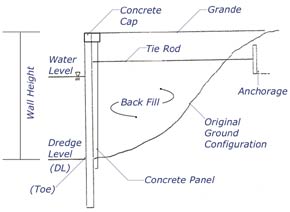Hello,
For the question #86 on the latest version of Six Minute solutions of Geotech, there is an anchored bulkhead supporting an excavation wall. I can not construct the geometry of the problem in my head.. so i couldnt understand the solution.
For the ones who dont have the book, the question says, an anchored flexible bulkhead, which is fixed from rotation and horizontal movement, is supporting a large excavation. the bulkhead is installed 35 feet deep.The excavation is 20 feet deep. The tie rod will be installed at 5 feet depth, and at a sufficient distance behind the active wedge. it asks for the tensile force in the tierod per unit width of bulkhead. the question gives parameters for the soil also.
Can someone help me to establish the geometry of this problem, or if possible draw a sketch of it and show it? because of not understanding the geometry, i also didnt understand how the pivot point is calculated in the solution. i know what bulkhead means but i dont know what they mean by anchored flexible bulkhead in the first place.
For the question #86 on the latest version of Six Minute solutions of Geotech, there is an anchored bulkhead supporting an excavation wall. I can not construct the geometry of the problem in my head.. so i couldnt understand the solution.
For the ones who dont have the book, the question says, an anchored flexible bulkhead, which is fixed from rotation and horizontal movement, is supporting a large excavation. the bulkhead is installed 35 feet deep.The excavation is 20 feet deep. The tie rod will be installed at 5 feet depth, and at a sufficient distance behind the active wedge. it asks for the tensile force in the tierod per unit width of bulkhead. the question gives parameters for the soil also.
Can someone help me to establish the geometry of this problem, or if possible draw a sketch of it and show it? because of not understanding the geometry, i also didnt understand how the pivot point is calculated in the solution. i know what bulkhead means but i dont know what they mean by anchored flexible bulkhead in the first place.






















